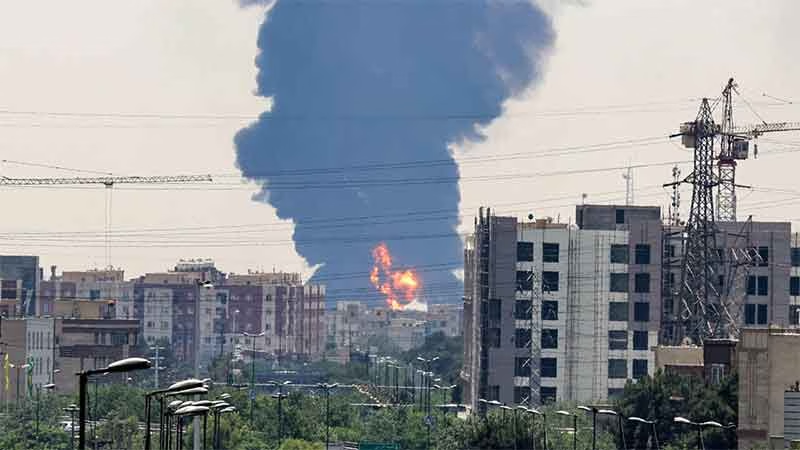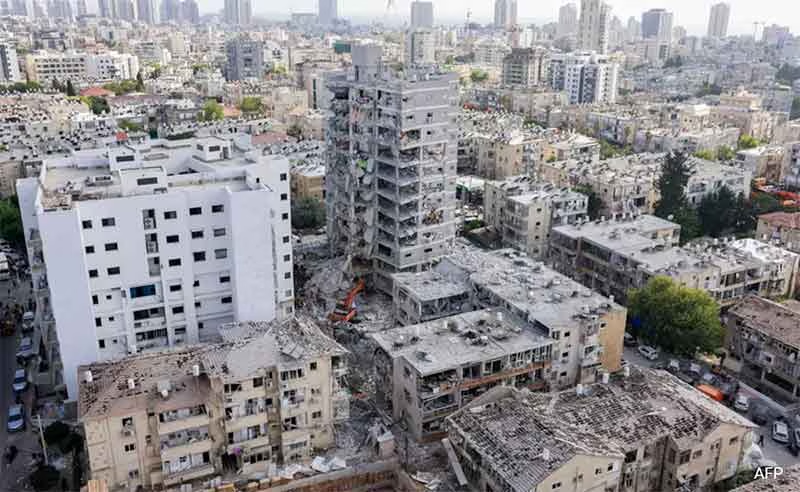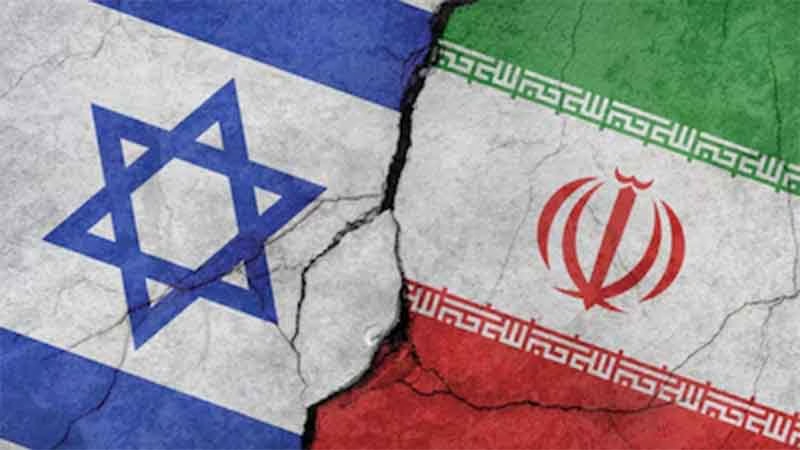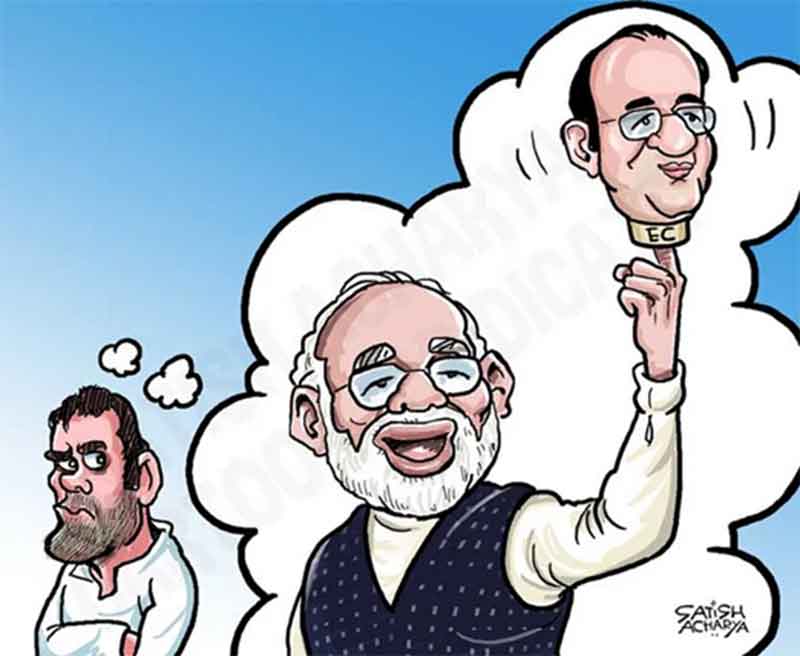
“Election Commission (EC) is behaving like BJP’s puppet,” complained many including the Congress. “EC has emerged as a significant loser in this election,” said a senior fellow of CPR, referring to its loss of credibility.(Cartoon Courtesy: cartoonistsatish.com).
The setbacks to BJP and gains to INDIA can not alter the fact of erosion of faith in EC. It will haunt the Modi-led BJP regime all its life, apart from the sanctity of the election process itself…irrespective of who won and who lost.
Soon after the declaration of election results on June 4, PM Modi in a BJP meeting said:
“I would like to thank the Election Commission of India for carrying out the world’s largest elections… ” and added that India’s electoral process has reached “new heights of credibility and efficiency.”
But few independent observers shared his view. Nor facts justified his claim, irrespective of who won and who lost.
It was the world’s costliest election, in a developing country with a very low HDI, making a mockery of expenditure limits (Rs.95 lakh per MP candidate, in most, larger constituencies) laid down by the EC: Nearly Rs. 1.35 lakh cr was expected to be spent, more than double that spent in 2019 , and more than Rs. 1.2 lakh cr of USA polls in 2020 (India Today, May 31,2024). Voters were openly purchased and wooed, apart from freebies hiked as if in an auction.
BJP was the biggest spender, and the Supreme Court verdict in the Election Bonds case formally exposed the public secret. Modi regime through various means deprived the opposition, Congress in particular, which complained it was handicapped by lack of funds. That was the case with sudden demonetization of Big currency too. The role of money is apart from factors like caste, religion, liquor etc, was a significant factor, more than ever.
Misuse of authority, Centre’s agencies (like ED CBI IT) including police, was brazen. Two CMs were imprisoned, denying a level-playing field. The Supreme Court’s relief to Arvind Kejriwal was too little and too late, though marginally helpful.
PM Indira Gandhi’s election was set aside by a High Court for far flimsy reasons and it was hailed by the liberals. It was a major factor that led to imposition of the Emergency in 1975-76. Can any Court dare to do so now? And what will be the consequences if one dared to?
Ideologies had little relevance: A ‘Congressized’ BJP itself lured candidates, in significant numbers, from other parties, some of them just days before nominations began.
A senior Fellow of Centre for Policy Research, an establishment think-tank, aptly commented:
“ EC has emerged as a significant loser in this election… It failed to embrace its independence and was unwilling the impose the Model Code of Conduct on party leaders..It wasted time arguing against public data disclosure..As a result, faith in the integrity of the election’s conduct has to shrunk to levels not seen since the pre-TN Seshan era…the erosion of credit of EC inevitably leads to erosion of faith in the electoral process” ( Gilles Verniers, OpEd, Economic Times, June 5, 2024, the day election results were published. ET has been pro-Modi.)
The setbacks to BJP and gains to INDIA can not alter this fact of erosion of faith in EC. It will haunt the Modi-led BJP regime all its life, apart from the sanctity of the election itself. Irrespective of who won and who lost.
Modi had appointed two Election Commissioners, it may be recalled, just on the eve of commencement of the election process, even as one was eased out (“resigned”) without stating reasons. The seven-phase election was decided upon, irrationally and arbitrarily, only to suit BJP and Modi. UP for instance had polling in all the seven phases.
Model Code of Conduct violated with impunity, particularly by the PM
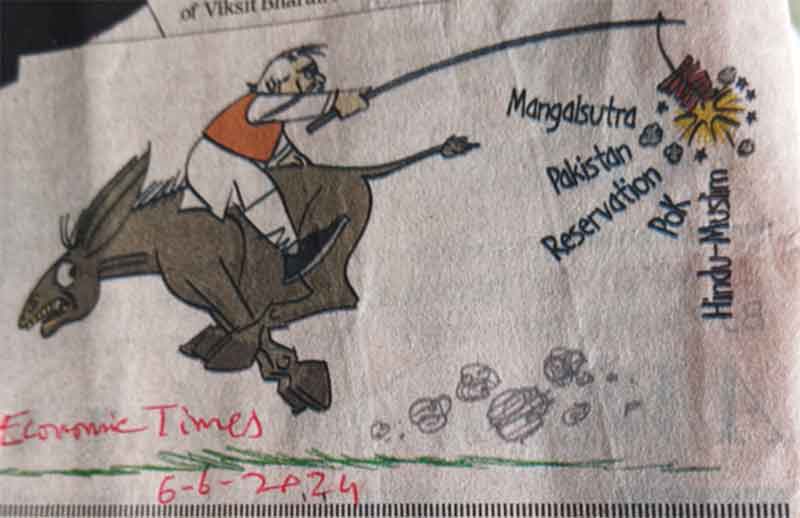
Cartoon Courtesy: Economic Times, June 5, 2024, (not June 6) the day results were reported. The EC did not act despite complaints of brazen and repeated violation of Model code of Conduct by Modi. But voters, more so in UP, punished him. “voters said they did not like the words and phrases used by Modi.” A BJP leader acknowledged it hurt the vote. (ET June 6, 2024).
“ This was the most openly communal and aggressive national campaign of Modi, who railed against the Muslim community, and less-so veiled ones against the Opposition, in his rallies, especially in the later phases of electioneering…” added Verniers:
“ A combination of these factors led to a lower turn-out..”
The turn-out was particularly low in UP, where Modi- Yogi Adityanath double-engine was much advertised. It was lower than elsewhere, in every phase. It began with 60 percent plus in phase-1, but fell down later, to hover between 54 and 58 percent. The All India voter turnout was 65.79%, as per EC. It was 54.24 % in Modi’s Varanasi, despite high-voltage campaign. Modi’s campaign was degenerate and repulsive.
E A S Sarma, Former Secretary to the Government of India, an upright bureaucrat, wrote a series of letters to the EC raising the question of its credibility. In one of them, a very early one dated 11/09/2023, he wrote:
“ In recent times, there have been questions about the credibility of the Commission as an independent authority under Article 324 of the Constitution and the apex court has suggested that the government should consider setting up an apolitical group to search for and select candidates to be appointed to the Commission so as to enhance its credibility. Somewhat deviating from the norms suggested by the apex court, the Centre has responded by introducing the CEC and Other ECs (Appointment, Conditions of Service and Term of Office) Bill, 2023, which, in my view, will render the Election Commission subservient to the Central political executive, rather than enhancing its independence.
“ It is ironic that the present Commission, by toeing the line of the political executive in the matter of conducting simultaneous elections should unwittingly or otherwise, confirm the apex court’s apprehensions about its ability to function effectively as the custodian of free and fair elections as envisaged in the Constitution and the laws enacted under it.
Constitutional expert and former secretary general of the Lok Sabha P D T Achary told Prasanna D Zore/Rediff.com how the Election Commission of India didn’t act against those who blatantly violated its model code of conduct related to conducting free and fair elections…”from the paper reports and all that, the violation of the model code of conduct (MCC) has happened too often and the violators were senior political leaders. Now the question is why the MCC which enables us to have a free and fair election, provide a level playing field, was allowed to be violated…“You can’t have a free and fair election if you don’t ensure that the MCC was upheld in the letter and spirit.”
Complaints against Rahul Gandhi, the Shehzada (prince) in Moi’s words, and the monarch Modi were equated and clubbed by the EC, which ultimately did not seriously try to curb violations of MCC. The EC however suspended campaign for a couple of days of some non-BJP leaders like KCR of Telangana, and a congress leader.
*** ***
Fudging numbers: Controversy over voting figures in Supreme Court
“I would like to thank the Election Commission of India for carrying out the world’s largest elections, ” said the PM, and added that India’s electoral process has reached “new heights of credibility and efficiency.”
Soon after the declaration of election results on June 4, addressing a meeting at BJP Hq in Delhi, PM Modi said these words and added: “NDA’s victory for the 3rd time represents the victory of 140 crore Indians.”
(https://www.narendramodi.in, June 4, 2024).
Modi’s words that India’s electoral process has reached “new heights of credibility and efficiency, ” are far from truth; contrary is the reality. Both credibility and efficiency in fact touched new lows, as was evident from all accounts. This article focuses on this aspect, even as Modi is sworn in as the hat-trick PM on June 9 Sunday.
“ All is well that ends well”…Is that the right approach when serious doubts and aspersions were cast on many processes and related authorities, during and after the latest elections to the Loksabha?
A voter turnout of 65.79 per cent was recorded in the just-concluded Lok Sabha elections but the final figures may change as it does not include postal ballots, the Election Commission said on June 6 Thursday, long after the final results were declared on June 4. Voter turnout at polling stations means votes polled in electronic voting machines (only). ( PTI, Jun 07 2024).
Does it reflect the efficiency of the EC ? Or boost its credibility?
Neither BJP nor even NDA got majority, i.e., more than 50 percent votes polled. BJP itself won 36.56 percent of polled vote, lower than in 2019. Total votes polled by BJP were 235.9 million, and those by NDA 274 m, which mean 42.7 percent of total polled votes. The total eligible voters were 968 m, and 642 m voted. It works out to around 24.5% of India’s electorate, ie, less than one fourth: How can Modi claim that victory of NDA represents the victory of 140 crore Indians?
We shall now go into the claim that the “electoral process has reached “new heights of credibility and efficiency.”
The Election Commission (EC) of India has released the “absolute number of voters for all completed phases” in a press note issued on May 25, 2024. Phase 1 took place on April 19. And four phases were over by then. Why was it so late, and why the data were released then on May 25?
The Supreme Court on May 17 asked the EC why it was not supplying the total absolute numbers of votes, as it has always done. A bench headed by chief justice of India (CJI) D.Y. Chandrachud has given seven days for the EC to file its response and posted the matter for hearing on May 24, which is a day before the sixth phase, out of 7 phases in all.
The Court asked for the release of the absolute number of votes cast in each of the phases completed by then and for making Form 17C available to voters at large by posting a copy of it on the ECI’s website.
By then fourth phase of the voting was over. Only then the EC released the final (provisional) figures for the four phases, for the first time, and that too only after the top court intervened. (More on it later in this article.)
EC’s counsel told the Court that after polling is completed, the returning officer (RO) collects data from the entire constituency, which takes time. This, as there are some constituencies at far flung places and there are others where re-polling has been ordered.
The fact is there was no re-polling anywhere in Tamilnadu, Kerala, AP and Telangana. Re-polling was ordered in only one booth of Karnataka’s Chamarajnagar Dt; that was on April 29, weeks before the matter came up in the Court. In Assam, re-polling was ordered in only four booths. Thus re-polling was only a lame excuse by EC. It can not be a reason for withholding data; if inevitable, data pertaining to those few booths could have been omitted.
It takes time, that was the other reason cited…what is the reality?
“There is no reason for delays in getting voter data. This data is in the system in real time…within five minutes of the polling ending, all information is available. Now, in this situation, the Election Commission is accountable for why so much time is being taken to finalise the data.” (Qureshi told Dainik Bhaskar.)
That is what was asserted by Former Chief Election Commissioner S.Y. Qureshi. He was the EC chief when EVMs were introduced to ‘speed up’ the election process and make data available fast. He is well versed with how data flows into the election system.
For phase 1, it took the EC 11 days, and four days each for three subsequent phases, to publish the final numbers that are available “within five minutes” of the polling.
Thus the claim of “efficiency” is not borne out by facts. On the other hand by the way EC behaved inside and outside the top Court, its credibility also was undermined.
*** ***
Actual numbers of votes: the credibility of the election process and of the EC questioned
The Supreme Court on May 17 asked the EC why it was not supplying the total numbers of votes, as it has always done. A bench headed by chief justice of India (CJI) D.Y. Chandrachud gave seven days for the poll panel to file its response and posted the matter for hearing on May 24, which is a day before the sixth phase of polling, held in seven phases.
The Supreme Court asked the EC, “On what basis do you disclose the tentative voting percentage. Is it based on Form 17C? What is the difficulty of putting this on website?”
Advocate Prashant Bhushan said that all polling officers in election booths are mandatorily required to fill up Form 17C and submit to the returning officer (RO). This form has the actual figures of voting which needs to be uploaded by EC.
EC’s counsel did not contest that. Instead, he pleaded time factor, re-polling etc, flimsy grounds as seen above. The Hindustan Times reported that the hearing took place on the last working day before the court’s vacation and resumed at 6 pm.
Former Additional Secretary Home Affairs Sanjeev Gupta said, “Can the [Election Comission] not embarrass themselves any further? I reiterate that Form 17C data of voters is entered boothwise in ECI’s ENCORE web based software. Data is available with them at the press of a button. How can they then say that they don’t have actual numbers of votes cast?”
Elections are a game of numbers, it is said. Actual numbers of votes cast, rather than voting percentages, is a most crucial factor. An election may be lost, as indeed it happened, by very narrow leads.
BJP won by a narrow margin of less than 500 votes in 30 constituencies, and by less than 1000 votes in over 100 constituencies. Citing these figures, Ms. Sujata Rao, a former Union Government Secretary, pointed out that the EC was yet to clarify how excess votes (increased percentage of votes polled) were recorded several days after polling was over (More on it later). She recalled Prof Sabyasachi Das (then of Ashoka University) said voting figures could be tampered particularly when such low margins are involved. Counting of postal ballots – in hundreds per each constituency,this time more than ever, the facilty being extended to new sections – became a controversy, going upto the Supreme Court.
Sabyasachi Das’ paper is ground breaking. But ‘democratic backsliding’ is gross exaggeration. That was the title of a report in the theprint.in(10 August, 2023). It says:
“What makes Das’ paper especially interesting is that he looks at the 2019 Lok Sabha elections—which has been the subject of a number of controversies. There were news reports of thousands of voter IDs being deleted because of new rules linking Aadhar to electoral rolls. The Election Commission messed up while sharing post-election data—the first set of figures released had a mismatch between the count of the people who voted (voter turnout) and the count of total votes (final results). A fresh approach to this highly debated election is both smart and welcome…”
“Yet, Das is careful to clarify that he does not claim that the manipulation changed the outcome of the election—writing instead: “The paper is unable to comment on the overall extent of manipulation in the 2019 general election.”
“Das, therefore, does not look at all 543 Lok Sabha seats, but zeroes in on seats where the outcome was a close call—59 constituencies where the difference in vote share between the top two parties was less than 5%.
“ In such close elections, the laws of probability say that both parties will have roughly equal chances of winning—50-50. Think of it this way: at such a neck-and-neck stage, the ultimate victor should be almost random. Therefore, among those 59 seats, one would anticipate BJP securing somewhere around 30 victories. However, BJP managed to snag 41 seats—11 more than the expected tally.
The current election is a closely contested one. BJP won by low margins in many constituencies, and that mattered, as pointed out by Sujata Rao (see above)
ECI has taken a stand that publication of absolute number of polled votes should remain secret till declaration of results…In their affidavit before the Court, the ECI has claimed that ‘secrecy protects democracy’, without dealing with the right of the petitioner to claim data on polled votes.
ECI cites Article 329 (b) of the Constitution to say that publication of poll data as demanded by the Petitioner will interfere with elections underway and will affect consistency of the election process.
A team of legal fraternity rightly contested the above arguments, and questioned the EC, as reported by countercurrents.org on 23rd May, 2024. It is worth quoting at length as it mentions the facts too:
“National Alliance for Justice, Accountability & Rights (NAJAR), as a collective of concerned legal professionals across India, strongly disagrees with and disapproves the Affidavit filed by Election Commission of India (ECI), in the ongoing case before the Supreme Court, regarding disclosure of voter turnout data. ECI has taken a stand that publication of absolute number of polled votes should remain secret till declaration of results.
“ The affidavit, we earnestly feel, is logically flawed, inherently inconsistent and contrary to the manner in which persons representing the constitutional body are expected to uphold the law. The arguments put forth by ECI are antithetical to the right to information of citizens, as upheld by the Hon’ble Supreme Court in multiple instances…
“… there is no connection shown as to how publication of poll data will affect the poll process and how non-publication will not affect the poll process. We find this stand of ECI legally and logically untenable. We wish to state that ‘Transparency’ is an essential element of democracy, not ‘secrecy’ as claimed by ECI in its affidavit..”
“ Secondly, in their own affidavit, they have stated that the form 17-C containing the polled data for each polling centre/booth is signed by the polling agents of the candidates; therefore, the data is already revealed to public, albeit in a consolidated form thus, what purpose would hiding data already known to public fulfill?…
“By denying credible and true information, ECI is denying the voters objective information and raises doubt on intentions of ECI. Why does ECI want to keep voters in hiding about poll data, is a question that merits urgent and clear answers…
“The Election Commission of India has concealed before the Apex Court that such data has been published by ECI in previous elections, including the 2014 and 2019 elections. This tantamounts to suppression of facts known to the ECI before the Apex Court…
“Both the delay in publishing polled voters date and increased percentage of the polled data (in provisional and final counts) is unprecedented in the 2024 Parliamentary elections. Previously ECI has taken the stand that data is collected in real time and that is why it is dynamic is nature. It is, therefore, obvious that ECI collects data and there is no way ECI could have calculated percentage without total tally of polled votes, as against total votes..”
“ This untenable stand of ECI to maintain ‘secrecy’ smells foul and is inconsistent with the previous conduct of the ECI. The reasons cited in the Affidavit to deny information are fatal to logic, inconsistent, and delusional..”
It also cited how SBI tried to delay the publication of data on electoral bonds, and the final verdict. It added: “ECI took no action in the cases of Indore and Surat, wherein the ruling govt. influenced the electoral prospects, with brute power. ECI took a rather mechanical stand that ‘everything has been done as per procedure’. In the recently concluded Chandigarh Mayor elections, tampering with polled votes was caught on camera and the candidate of BJP was declared ‘winner’ by the Returning Officer…”
Hiren Gohain, a political commentator, rightly recalled and remarked:
“The beginnings of the present ECI are themselves mired in some form of deviation from strict principle.The Prime Minister and a member of his cabinet have the decisive voice in the three-member selection committee.This leaves the very composition of the ECI open to question. And for all one can see, instead of justifying public confidence in its functioning the ECI seems to be behaving oddly in ways that arouse anxiety and suspicion in the public mind…
“ Given the circumstances (of a crucial election) it is not unnatural for a suspicion to arise that the ECI has been charged with the task of engineering a credible victory for the Modi offensive through use of such expedients as tampering with EVMs…
“The vacation bench of the SC has hinted that the discrepancies may be considered by it AFTER the poll results. This, with respect makes no sense. If evidence comes to light later of tampering with real figures in some booths,the possibility will transpire that there had been similar and other mala fide interventions in all or most constituencies.
In such a case one cannot see how the SC will be able to declare the whole election invalid and call for another round of polling. Further the circumstances would have proved the ECI itself guilty of serious partiality and hence deserving immediate dissolution.How will the new ECI be formed and by what procedure?
Lastly,If Modi returns to power with such a stratagem,will he step down quietly?
All things considered, the doubts and questions need to be settled to the satisfaction of the public BEFORE Poll results.
It has clearly shown bias in ignoring the Prime Minister’s incredibly communalist claims and comments, repeated many times during his election campaign.
(by Hiren Gohain, 25/05/2024, Countercurrents.org)
*** ***
EC showed “an increase in 1.07 crore” voters across 379 constituencies, at an average rise of 28,000 votes per constituency! Does it keep its credibility intact?
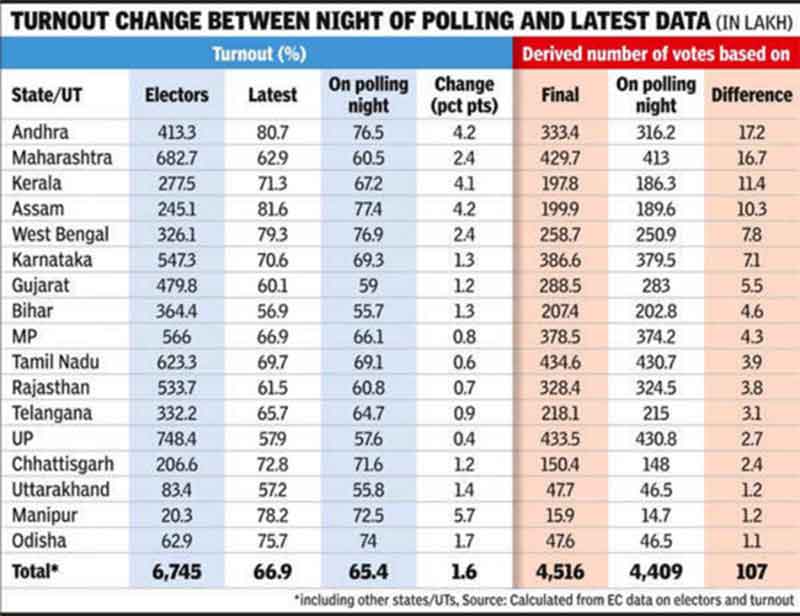
Source: TNN / Times Insight Group, May 18, 2024.
“ An analysis of turnout numbers put out by EC late night of the day of polling in each phase and the latest updated numbers shows that the difference could be nearly 1.07 crore votes over the first four phases of the 2024 Lok Sabha polls. That’s an average of over 28,000 votes per constituency for the 379 that have finished polling.”
The above data and analysis raise serious doubts on the credibility of the election process and of the EC, and belie the claims made by PM Modi.
As per a Times Insight Group analysis, the revised percentages would translate to “an increase in 1.07 crore” voters across 379 constituencies for which votes have already been cast. The average rise per constituency is “28,000 votes.” The analysis has been carried out between numbers given by the EC on the same day as the polling in each phase and then the final numbers made available by the Commission.
“Such calculation backward shows that the implied difference in number of votes for the two turnout figures was about 18.6 lakh for phase 1, 32.2 lakh for phase 2, 22.1 lakh for phase 3 and 33.9 lakh for phase 4, totalling up to 1.07 crore.”
The numbers thus went up in later phases, even as doubts arose about Modi’s hat-trick claims. His 400 plus rhetoric was busted.
“The biggest variations were in Andhra Pradesh (AP), 4.2 percentage points in turnout and 17.2 lakh in derived vote numbers, Maharashtra (2.4 percentage points and 16.7 lakh), Kerala (4.1 percentage points and 11.4 lakh) and Assam (4.2 percentage points and 10.3 lakh). In Assam’s case, that translates to an average difference of over 73,000 per constituency. For Andhra Pradesh, the average is 69,000 and for Kerala 57,000. Karnataka at 51,000 and Maharashtra at 48,000 have also seen significant differences. The variation in the Hindi heartland states was on the lower side.” (BJP was aware that those states won’t help BJP this time, and was seeking to boost its tally in the south.)
AP mattered very much, as also other states. It was AP and TDP-led alliance that came to the rescue of Modi-led BJP, with 21 seats out of 25. Thanks to the alliance, BJP that had polled less than one percent vote in 2019, won 8 seats now in 2024.
YSRCP, the ruling party of AP got, even now, almost 40 percent of polled vote, but won only 4 Loksabha seats, and only 11 assembly seats out of 175 (down from 151). It was shocking, unbelievable even to to the TDP.
Doubts are widely raised about tampering of votes/EVMs, apart from the brazenly partisan role of the EC, the Centre, the police and the administration. Two dozens of senior IAS and IPS officers were shifted, “with immediate effect”, midway through the election. It happened on the very evening of Amit shah’s AP election tour, in response to a representation by Daggupati Purandeswari,who was lately appointed the State President of BJP; a notorious turn-coat, she was lured into BJP, and as an MP now, will likely play a key role at the centre (being considered for the post of Speaker or deputy speaker). She is a daughter of NTR, and close relative of TDP chief Chandra babu.
Subscribe to Our Newsletter
Get the latest CounterCurrents updates delivered straight to your inbox.
So also Karnataka, now ruled by Congress, mattered, where BJP won 17 seats out of 25. And in Maharashtra, Shiv sena’s Shinde faction with 7 seats came to the rescue of Modi, even as Sharad Pawar could save his turf. All these saved the BJP and the NDA, and Modi could make a hat-trick as PM.
Thus the whole Loksabha election process was highly dubious, with EC’s credibility undermined, and it taints the results.
The setbacks to BJP and gains to INDIA can not alter the fact of erosion of faith in EC. It will haunt the Modi-led BJP regime all its life, apart from the sanctity of the election process itself…irrespective of who won and who lost.
*** ***
Ramakrishnan is a political commemorator who contributed to the countercurrents.org.
































